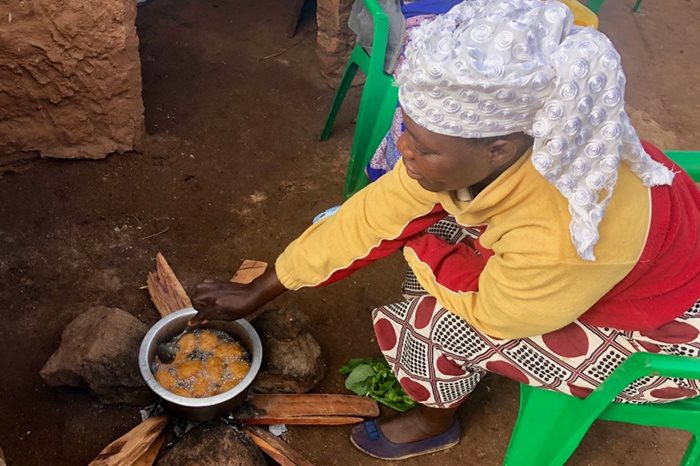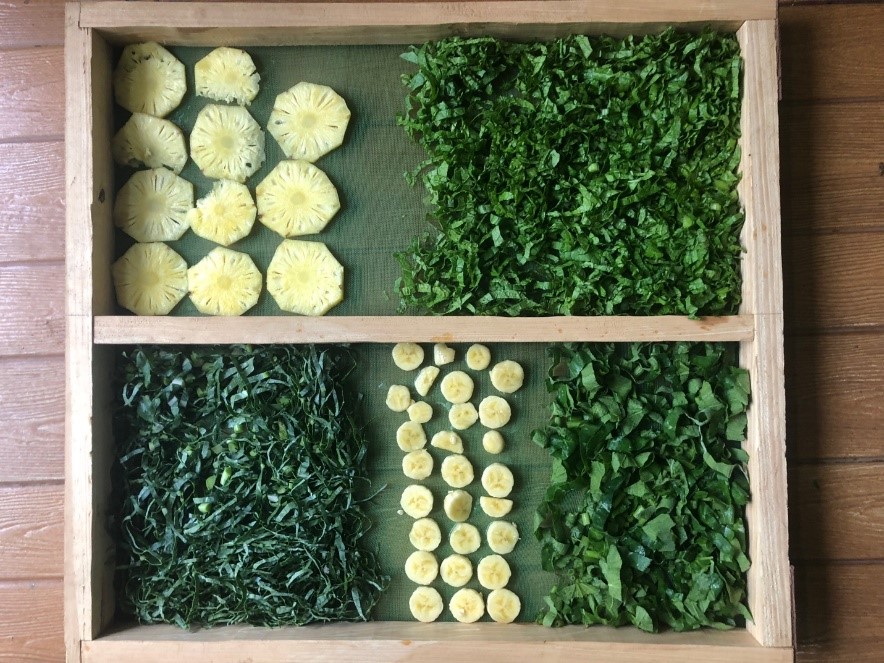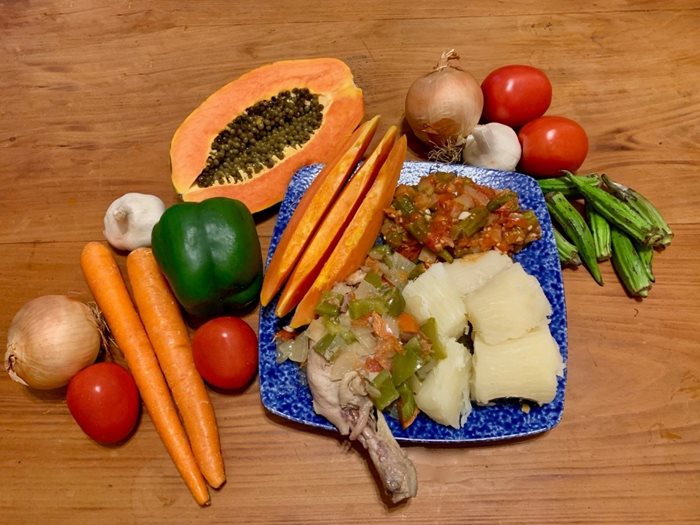In Mozambique, a Feed the Future cookbook is serving up nutritious, farm-to-table recipes. Taking a holistic approach to gastronomy, the book underscores how food systems are inherently tied to climate, health, and gender considerations.
Banner photo: The cookbook explains how to dehydrate vegetables to preserve them through the off-season.
All home cooks can appreciate the hallmarks of a trusty cookbook. Think back to some of your own favorite cookbooks. The ones that you keep coming back to — the ones that get covered in flour and callused with dogears — are the ones that are useful. They make sense for your time and in your home. They strike the delicate balance between tradition and innovation — sparking both comfort and delight in the hearts of their readers. Oftentimes, they are socially conscious. They are attuned to a home cook’s realities —whether it’s a nod to the importance of a nutritious meal, or an appreciation of which seasonal and local ingredients are accessible, or an acknowledgment of the shifting nature of our global food systems in the wake of climate change.
In Mozambique, one Feed the Future project infused these key ingredients into a comprehensive cookbook, taking a holistic approach to farm-to-table cooking. Known simply as
Cozinha Moçambicana, or Mozambican Cuisine, the cookbook features traditional Mozambican recipes such as badjias (a fried snack), fried okra, fish soup, and matapa stew. In a country where climactic shocks are increasingly common and where many communities still struggle to
access nutritious meals, the cookbook was developed by the
Feed the Future Mozambique Resilient Agriculture Market Activities – Beira Corridor (RAMA-BC) project for residents of Manica and Sofala to help meet the broader efforts of the project to equitably increase local producers’ agricultural productivity, while increasing resilience to climate change.
Peppered with practical tips and resources,
Cozinha Moçambicana is a practical farm-to-fork cooking guide that takes a holistic approach to Mozambican cuisine, created specifically for smallholder Mozambican farmers, students, and village saving loan association members (community members who meet regularly to generate savings together and generate loans). It offers practical advice ranging from illustrations on how households can maximize the productivity of their garden plots, to step-by-step instructions for building food dehydrators to preserve vegetables and other ingredients for the off-season.
At the Crossroads of Innovation and Tradition: Finding the Sweet Spot
At the intersection of tradition and innovation, the cookbook relies on classic Mozambican recipes and ingredients while promoting new cooking and preparation techniques to help households make the most of what they can find in their own backyards.
In a country where agriculture dominates the economy, Mozambican cuisine often relies heavily on local, organic ingredients — revolving around tasty stews, local vegetables, fresh seafood, and porridges. The recipes in Cozinha Moçambicana pay homage to these traditional recipes and ingredients, but they incorporate new ingredients and techniques that maximize the productivity of smallholder farmers’ gardens. For example, matapa — a classic Mozambican stew, traditionally made from cassava and coconut milk — is re-imagined using lablab leaves, a crop that is nutritious and available for longer periods of the year. Meanwhile, badjias — a Mozambican bean fritter that is traditionally made from cowpeas — are adapted using pigeon peas.
 Madalena Mario, from Matica village, cooks pigeon pea badjias (fritters) using the cookbook.
Madalena Mario, from Matica village, cooks pigeon pea badjias (fritters) using the cookbook.
These culinary innovations are sticking — many households are now turning to these ingredients that were often underused. Smallholder farmer Isabel Mario from Baiane, Macate, Manica province shared: “My family likes the flavor of lablab leaves. It’s not different to cowpea leaves (which we know). I didn’t know that you could eat these leaves, which now make up part of my family’s diet.” Because of these changes, small garden plots and farms are becoming more fruitful, allowing households to enjoy the full vegetable product while maximizing crop growth through climate-sensitive techniques such as
intercropping.
Through these innovations,
Cozinha Moçambicana encourages climate-sensitive approaches to agriculture — wherein agricultural productivity is maximized to get the most out of the land and ingredients are consumed from root to stalk. In the age of our climate emergency, these approaches are more important than ever for helping communities cope with the effects of climate change.
 The cookbook features step-by-step instructions for building a food dehydrator and preserving fruits and vegetables through off-seasons.
The cookbook features step-by-step instructions for building a food dehydrator and preserving fruits and vegetables through off-seasons.
“My Plate”: Cooking to Combat Malnutrition
Dalva Hassane, a Land O’Lakes Venture37 gender expert on the RAMA-BC project, and one of the authors of the cookbook (and a co-author of this blog post) explained the thought process behind the cookbook. During her work in agricultural development, she began to see the realities of malnutrition and how it was severely affecting the health of people — especially children — even though many households grow produce in their own backyards. She wanted to develop the cookbook with her team to equip local communities with the tools to fight malnutrition with their own produce, ultimately helping households re-discover traditional recipes through the lens of a healthy, balanced diet. Beyond her expertise in gender-sensitive programming, Dalva owns a restaurant featuring Mozambican dishes in Nampula city, so she contributed many of her own nutritious recipes to the book.
In Mozambique, chronic malnutrition remains high, affecting almost one in every two children under the age of five. Using a “MyPlate” approach, the cookbook shares nutritious recipes that include diverse, balanced meals featuring portions of fruit, grains, vegetables, and protein in each meal. The cookbook is also steeped in guidance for maximizing the nutritional value of common Mozambican ingredients, such as how to germinate beans, optimal cooking time to maximize vitamins in leafy greens, and tips on re-using the nutrient-rich water that comes from cooking vegetables in it.
These practical tips on food enrichment are playing a significant role in bolstering diets in a context where childhood stunting is common. Using the tenets of the cookbook and by distributing the cookbook, the project was able to help 450 families in Sofala through training sessions, demo plots, and cooking demos, among which 250 families were seen adopting new cooking techniques that helped maximize the nutritional value of their meals.

Dalva believes that Mozambican cuisine defines her in many ways. It brings back strong memories of cooking in her own childhood home, and it plays a crucial role for the health and wellbeing of all people in Mozambique. Dalva recalls one dish in particular: an okra stew that her grandmother cooked for her as a child to help her recover from a stomach parasite. The okra dish is still one of her favorite dishes because of its health benefits. The recipe can be found below.
Inclusive Cooking
Beyond its considerations for climate-sensitive agriculture and nutrition, the cookbook also sheds light on the intersection between food systems, gender, and youth. These recipes are the basis for many women to be able to generate income through local savings groups – an important way for female smallholder farmers to build financial independence and access finance for small business opportunities. Using the recipes, savings group members have launched small women-owned culinary businesses with the support of the RAMA-BC project.
For example, Ana Maria from Herois Moçambicanos, near Chimoio explained, “I didn’t know that you could make badjias from pigeon pea. I now sell it in the market and it sells quickly. I have also taught two of my friends how to make it.” These sales have also stimulated interest in the commercial value of locally grown, healthy produce.
With women often responsible for childcare and household chores such as collecting wood and water and farming, the cookbook offers practical ways that children can help out with gardening, therefore freeing up more of women’s time for other pursuits. For example, it explains how children can help water the vegetables and help out with weeding to be active members of the household.
In a nutshell, Cozinha Moçambicana has all the ingredients for a perfect cookbook. It features nutritious, tasty recipes that home cooks in Mozambique can keep coming back to, underscoring the nexus between the food on our plates, health, climate change, and social inclusion.
Okra Stew (Guizado de Quiabo): A Recipe from Dalva Hassane
One dish that I want to share from the cookbook is a recipe for a fried okra recipe that my grandmother used to prepare for me. I remember being ill as a child with a stomach parasite, and my grandmother cooked me this okra dish to help me recover. It still remains an important dish to me because of its health benefits — it is very nutritional and provides energy throughout the day.
Ingredients:
- 1 pound okra
- 6 tomatoes
- 6 onions
- 1 teaspoon salt
- 6 cloves of garlic
- 3 tablespoons olive oil
Method:
Wash the okra and tomatoes. Using a mortar and pestle, grind the salt with the garlic into a paste. Slice onion, and roughly chop the tomato and okra. Heat oil over medium heat, then add the onion followed by okra and the garlic paste. Cook for approximately five minutes. Add the chopped tomato and continue to heat until the colors are beautiful and orange.
